
For far too long, many people have considered family life and urban life as being mutually exclusive. That trend is slowly reversing, as more and more parents choose to raise their kids in urban areas. However, city builders often fail to consider their smallest, most vulnerable users. As Enrique Peñalosa famously said: “”Children are a kind of indicator species. If we can build a successful city for children, we will have a successful city for all people.”
The following slideshow describes twelve ways we can make our cities more amenable to kids. These are by no means a comprehensive list, but are designed as a conversation starter. Have any suggestions? Leave them in the comments section!
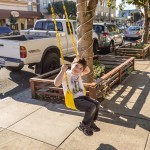 1. THE STREET AS A PLAYGROUND –
Sometimes, creating a unique sense of place can be as simple as hanging a swing from a tree. It’s an inexpensive and thoughtful gesture, and one that encourages kids to loiter, play, and utilize the entire street as a playground. Our family stumbled across this swing on Irving Street in S.F., which instantly became a highlight of our sightseeing afternoon.
1. THE STREET AS A PLAYGROUND –
Sometimes, creating a unique sense of place can be as simple as hanging a swing from a tree. It’s an inexpensive and thoughtful gesture, and one that encourages kids to loiter, play, and utilize the entire street as a playground. Our family stumbled across this swing on Irving Street in S.F., which instantly became a highlight of our sightseeing afternoon.
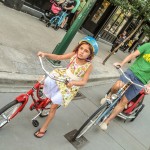 2. SPACE FOR CYCLING/SCOOTING – Most kids get their first taste of freedom on a bicycle, scooter, or skateboard. Tragically, there are precious few safe spaces in which to enjoy that autonomy, having long been relegated to parks and quiet, neighbourhood streets, making riding for transportation virtually impossible. The real visionary cities are ones that are providing cycle tracks on busy, destination lined high streets, where families actually want to live, shop, and play.
2. SPACE FOR CYCLING/SCOOTING – Most kids get their first taste of freedom on a bicycle, scooter, or skateboard. Tragically, there are precious few safe spaces in which to enjoy that autonomy, having long been relegated to parks and quiet, neighbourhood streets, making riding for transportation virtually impossible. The real visionary cities are ones that are providing cycle tracks on busy, destination lined high streets, where families actually want to live, shop, and play.
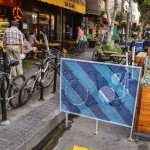 3. ACCESSIBLE & FUN PARKLETS – Parklets have become a fashionable and painless way to convert space allocated for on street automobile storage into shared public space. However, it is important that we design these features for users of all ages. The vast majority are simply used as private patios for cafes and restaurants, but it doesn’t have to be that way. This parklet, found on L.A.’s Spring Street, includes public seating, stationary bikes, and a foosball table!
3. ACCESSIBLE & FUN PARKLETS – Parklets have become a fashionable and painless way to convert space allocated for on street automobile storage into shared public space. However, it is important that we design these features for users of all ages. The vast majority are simply used as private patios for cafes and restaurants, but it doesn’t have to be that way. This parklet, found on L.A.’s Spring Street, includes public seating, stationary bikes, and a foosball table!
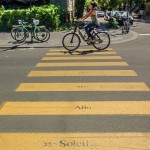 4. PLAYFUL & PLENTIFUL CROSSWALKS – On far too many streets, crosswalks are limited to major intersections; making getting from one side to the other a difficult and dangerous task. This often requires walking several blocks just to reach one, which is particularly difficult for little legs. Playful and plentiful crosswalks – such as this one in Montréal’s Mont-Royal – make crossing the street convenient, safe and fun, forcing drivers to slow down and become more alert.
4. PLAYFUL & PLENTIFUL CROSSWALKS – On far too many streets, crosswalks are limited to major intersections; making getting from one side to the other a difficult and dangerous task. This often requires walking several blocks just to reach one, which is particularly difficult for little legs. Playful and plentiful crosswalks – such as this one in Montréal’s Mont-Royal – make crossing the street convenient, safe and fun, forcing drivers to slow down and become more alert.
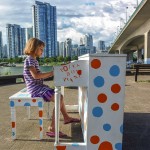 5. SHARED MUSICAL INSTRUMENTS – When the “Keys To The Streets” program unleashed four public pianos onto unsuspecting Vancouverites last summer, the results were extraordinary. Public plazas were quickly transformed into impromptu concert venues, as citizens gathered with various instruments (or just their voices) to join in on the action. Our family couldn’t pass one of these pianos without stopping and messing around on it for a half hour.
5. SHARED MUSICAL INSTRUMENTS – When the “Keys To The Streets” program unleashed four public pianos onto unsuspecting Vancouverites last summer, the results were extraordinary. Public plazas were quickly transformed into impromptu concert venues, as citizens gathered with various instruments (or just their voices) to join in on the action. Our family couldn’t pass one of these pianos without stopping and messing around on it for a half hour.
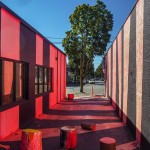 6. ACTIVATING OUR ALLEYWAYS – Alleyways are another otherwise wasted space waiting for reclamation, with little expense or possibility of controversy. This particular alleyway – off of Fraser Street in South Vancouver – cost little more than a few tins of paint, and provides a secure, visually appealing, much-needed social gathering place for adults and children alike.
6. ACTIVATING OUR ALLEYWAYS – Alleyways are another otherwise wasted space waiting for reclamation, with little expense or possibility of controversy. This particular alleyway – off of Fraser Street in South Vancouver – cost little more than a few tins of paint, and provides a secure, visually appealing, much-needed social gathering place for adults and children alike.
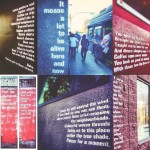 7. MEANINGFUL STREET ART – Street art has long been accepted as a way to beautify blank surfaces, and promote civic pride. When done in a meaningful manner, it also provokes thought, and rewards those who move about the city at a slower pace. The “Main Street Trail” project – initiated by a group of poets in Vancouver’s Mount Pleasant – had our family scouring the length of Main Street (by foot and bicycle) for weeks that summer, in search of the newest poem.
7. MEANINGFUL STREET ART – Street art has long been accepted as a way to beautify blank surfaces, and promote civic pride. When done in a meaningful manner, it also provokes thought, and rewards those who move about the city at a slower pace. The “Main Street Trail” project – initiated by a group of poets in Vancouver’s Mount Pleasant – had our family scouring the length of Main Street (by foot and bicycle) for weeks that summer, in search of the newest poem.
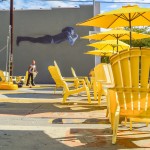 8. RE-IMAGINE SURFACE PARKING – It is difficult to understate the devastating affect that surface parking has on the vibrancy and walkability of a given neighbourhood. This parking lot – formerly used by a bank in Long Beach – has since been retrofitted with some yellow paint, a bicycle corral, two kickball stands, several chairs and umbrellas, and a wonderful mural of Jim Morrison.
8. RE-IMAGINE SURFACE PARKING – It is difficult to understate the devastating affect that surface parking has on the vibrancy and walkability of a given neighbourhood. This parking lot – formerly used by a bank in Long Beach – has since been retrofitted with some yellow paint, a bicycle corral, two kickball stands, several chairs and umbrellas, and a wonderful mural of Jim Morrison.
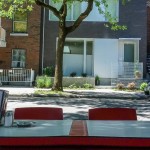 9. ENCOURAGE SIDEWALK DINING – The breaking of bread has always been a social act, yet increasingly, our society is doing it behind fences, railings, and closed doors. Sidewalk patios are a fantastic way to reverse that trend, and return eating to the more communal act it once was. This corner store in Montréal’s Mile End set up diner-style tables on the sidewalk, inspiring families to stop and interact with their neighbours over breakfast, lunch or dinner.
9. ENCOURAGE SIDEWALK DINING – The breaking of bread has always been a social act, yet increasingly, our society is doing it behind fences, railings, and closed doors. Sidewalk patios are a fantastic way to reverse that trend, and return eating to the more communal act it once was. This corner store in Montréal’s Mile End set up diner-style tables on the sidewalk, inspiring families to stop and interact with their neighbours over breakfast, lunch or dinner.
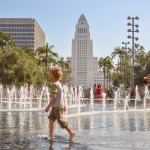 10. ACCESS TO WATER – It doesn’t matter where I’m travelling with my kids; we somehow always end up near water. While hanging out at the beach is the ideal scenario, we sometimes don’t have that luxury. Wading pools, splash pads, and water fountains are a parent’s best friend, and give families a place to gather, especially in the harsh heat of summer. L.A.’s Grand Park is a great example, providing a wonderful urban oasis in the heart of the city.
10. ACCESS TO WATER – It doesn’t matter where I’m travelling with my kids; we somehow always end up near water. While hanging out at the beach is the ideal scenario, we sometimes don’t have that luxury. Wading pools, splash pads, and water fountains are a parent’s best friend, and give families a place to gather, especially in the harsh heat of summer. L.A.’s Grand Park is a great example, providing a wonderful urban oasis in the heart of the city.
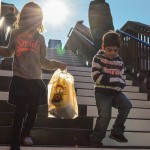 11. A TOUCH OF WHIMSY – To a child, often the most whimsical of touches are the most memorable ones. Urban planners need to start looking at their work through their children’s eyes, encouraging active and interactive play at every opportunity. For example, this public staircase – in S.F.’s Fisherman’s Wharf – functions as a giant piano, with every tread playing a different note. It kept my kids occupied – and physically active – for the better part of an hour!
11. A TOUCH OF WHIMSY – To a child, often the most whimsical of touches are the most memorable ones. Urban planners need to start looking at their work through their children’s eyes, encouraging active and interactive play at every opportunity. For example, this public staircase – in S.F.’s Fisherman’s Wharf – functions as a giant piano, with every tread playing a different note. It kept my kids occupied – and physically active – for the better part of an hour!
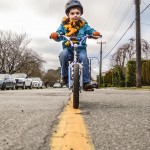 12. TAMING THE BULL – In general, anything that we can do to slow down motor vehicles, and make them feel like they are trespassing, will make our streets more kid-friendly. This includes – but is certainly not limited to – the narrowing of vehicle lanes, reduction of speed limits, blocking of through traffic, and an increase in the number of stop signs. Then – and only then – will children feel safe and welcome playing on the street outside their front door.
12. TAMING THE BULL – In general, anything that we can do to slow down motor vehicles, and make them feel like they are trespassing, will make our streets more kid-friendly. This includes – but is certainly not limited to – the narrowing of vehicle lanes, reduction of speed limits, blocking of through traffic, and an increase in the number of stop signs. Then – and only then – will children feel safe and welcome playing on the street outside their front door.

 ***
***
Chris Bruntlett is a Residential Designer and father of two, living the (car-free) East Van dream. Outside of the office, he diligently documents the rise of mainstream bicycle culture via words, photographs, and film. He cherishes the ability to live and work in a dense, vibrant, sustainable city, and contribute to that vision on a daily basis. You can find Chris on Twitter: @cbruntlett

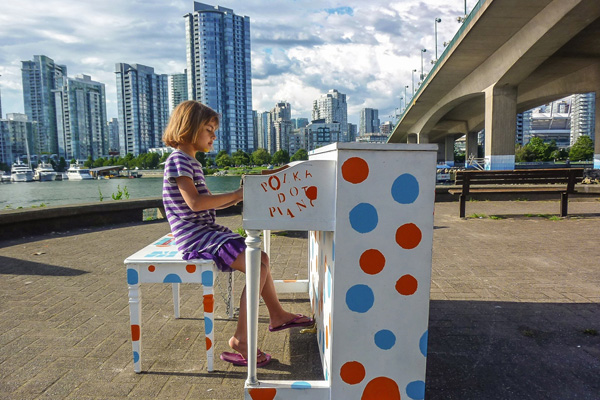

14 comments
Used to be that children actually played on the streets, because there were no cars to worry about. Today, the motor vehicles have conquered the streets, even spreading out asphalt to give them a smoother ride.
I have been thinking that a more useful approach to getting bikelanes installed, instead of focussing on “how do we get commuters downtown” would be to take the approach of “how do we get kids 12-15 safely to school.” A bike network that was a series of connected hub networks, with each hub being a public school, is still a network, and “Toronto is a city where it’s safe for children to bike to school” is a motherhood-and-apple-pie slogan most people could get behind.
R.
Thanks for your thoughtful list Chris! Great examples here – love the local Point Grey Road shot.
You’ve already noted that we should activate laneways and I’d like to add other underutilized spaces – like under bridges, empty lots, railway lands etc.
Kids love gardens too and any chance to get their hands dirty and learn how things grow is another plus.
The examples you note are not only beneficial to children but us older kids enjoy and learn from an activated and engaging public realm.
Great list! So colourful and fun for everyone! All of these ideas hinge on making public spaces into places to BE rather than just get through on the way to something else. I also really like Richard’s idea of community oriented bike lanes – so many kids in my downtown neighborhood never ride because of the perceived traffic issues. A decent school commute is the place to start.
I love the notion of playground everywhere. Hopscotch courts! Four square! Street tennis and handball. It’s all good!
How about outdoor reading rooms, with great children’s picture books? We’re doing this in New York City (see: http://www.theuniproject.org). Would love to find an organization to use our kit and do something similar in Toronto.
Fantastic post on a conversation that seldom involves our children. I would suggest one important addition to your list: cities and school boards need to work together to ensure that our children have more opportunities to walk and wheel to school and to do it safely! Tools like School Travel Planning can help get us there.
Great suggestions. I would add have “messages” on the public art extolling the virtues of a diverse city landscape (e.g., children, adults, families, and seniors). Oftentimes, cities are seen as playgrounds for adults, so I think people need to be reminded that they too were once children and to not denigrate the caregivers/kids who share the spaces with them.
C’est bien, bonnes idées. Mais un peu de verdure, de la végétation, des ruelles vertes, des jardins, des espaces verts SVP et des municipalités qui s’engagent réellement dans un vaste chantier de reverdissement avec des entreprises d’économie sociale, des groupes communautaires, et une vision à moyen terme. Fini le gazon synthétique sur les surfaces sportives et pour une pratique écologique des activités sportives.
Je suis prêt à soutenir une action concrète à Montréal.
Great list and comments – yes we need to think about play for all in the sense of a right to the city everyone, not just wealthy middle aged Monaco playboys! Got to provide sense of safety to allow a playful state of mind to run free. Ah yes, and stuff to play with, sand as well as water – and places to sit (for free) and watch others playing.
Look to the past a bit. I am 68 years old. I grew up in inner city Chicago in large apartments in large apartment buildings. We played on the sidewalks and sometimes in the alleys. Once and a while there were playgrounds at the end of our blocks in the older neighborhoods where we lived. We could walk to everything.
I have been living in Portland OR for the past 40 years. What I see today is large apartment buildings being built with tiny micro apartments not at all conducive to families living in them. They are very expensive. Why are there not the large apartments of the type I was brought up being built? Those are being torn down for these new ones. Schools are being demolished and consolidated.
Houses in the cities and the larger apartments that are left standing are not affordable for most families. They are being occupied by young adults who share the rent if they are rentals or by the more wealthy families who can afford to buy them if they are owned. Cities, at least mine, are not very inviting for average income families any longer.
If you want to make cities more inviting for kids, they have to be made more affordable for parents.
Great list and comments! Thanks to all.
We live in Rome (Italy) and I would like to report what my 7 years old daughter told me are her wishes : grass in the street! The countryside downtown. No cars (or the minimum), always move by bike or on foot. That she would love.
bye
Where are the ideas for cities with harsher climates? Sidewalk swings are great when it’s at least 45 (F) degrees and sunny, but some of us live where it’s 20 F with at least six inches of snow on the ground for four months a year. Spending this winter cooped up with small children in my small urban flat has made a big house in the suburbs seem more appealing than ever.
The Green Mama loves talking about kid-friendly cities, because, kid-friendly cities are people friendly cities. All of the comments on this blog are so thoughtful, smart, and beautiful as are the photos and ideas behind them. I second all of them: safe routes to schools, connected greenspaces, apartments designed for families, more streets designed for play, truly kid-focused bike (skateboard, rollerblade or whatever wheels) lanes. Another thing I have found having lived in a number of North American cities (Chicago and Vancouver) and in the developing world with children is that the “dumbed-down” American playground that Vancouver has taken to an extreme artform does children no favors. They are boring, they don’t challenge children, and they are no fun for parents or older kids and thus send the message that those groups should just go back inside. A good playground is fun–and challenging– for all ages. http://www.thegreenmama.com.
Thanks for sharing! Wanna do a playground blog together?